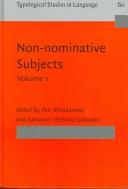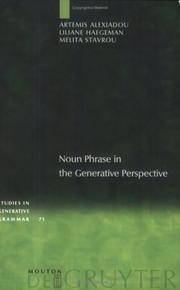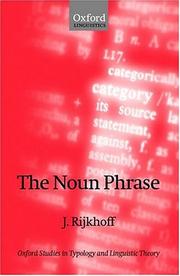| Listing 1 - 10 of 90 | << page >> |
Sort by
|
Book
ISBN: 3531125680 Year: 1995 Publisher: Opladen Westdeutscher Verlag
Abstract | Keywords | Export | Availability | Bookmark
 Loading...
Loading...Choose an application
- Reference Manager
- EndNote
- RefWorks (Direct export to RefWorks)
Grammar, Comparative and general --- Noun phrase --- Subject (Grammar) --- Noun --- Complex nominals --- Subject --- Nominals --- Lexicology. Semantics --- Linguistics --- Philology
Book
ISBN: 9789004260825 9789004261440 9004261443 900426082X 1306210178 Year: 2014 Publisher: Leiden Brill
Abstract | Keywords | Export | Availability | Bookmark
 Loading...
Loading...Choose an application
- Reference Manager
- EndNote
- RefWorks (Direct export to RefWorks)
Crosslinguistic Studies on Noun Phrase Structure and Reference contains 11 studies on the grammar of noun phrases. Part One explores NP-structure and the impact of information structure, countability and number marking on interpretation, using data from Russian, Armenian, Hebrew, Brazilian Portuguese, Karitiana, Turkish, English, Catalan and Danish. Part Two examines language specific definiteness marking strategies in spoken and signed languages-differentiated definiteness marking in Germanic, double definiteness in Greek, adnominal demonstratives in Japanese, 'weak' definiteness in Martiniké and the special referring options made avilable by signing. Part Three examines the second-language acquisition of genericity in English, Spanish and Brazilian Portuguese. This volume will be of interest to researchers and students in syntax, formal semantics, and language acquisition.
Grammar, Comparative and general --- Noun phrase. --- Syntagme nominal --- Noun phrase --- Subject (Grammar) --- Complex nominals --- Subject --- Nominals --- Comparative linguistics --- Grammar --- Linguistics --- Philology
Book
ISBN: 9780814274729 0814274722 0814274714 081421326X 9780814274712 9780814213261 0814253881 Year: 2017 Volume: *1 Publisher: Columbus The Ohio State University Press
Abstract | Keywords | Export | Availability | Bookmark
 Loading...
Loading...Choose an application
- Reference Manager
- EndNote
- RefWorks (Direct export to RefWorks)
"'Advances in the Analysis of Spanish Exclamatives' is the first book entirely devoted to Spanish exclamatives, a special sentence type often overlooked by contemporary linguists and neglected in standard grammatical descriptions. The seven essays in this volume, each by a leading specialist on the topic, scrutinize the syntax, as well as the semantic and pragmatic aspects, of exclamations on theoretical grounds. The book begins by summarizing, commenting on, and evaluating previous descriptive and theoretical contributions on Spanish exclamatives. This introductory overview also contains a detailed classification of Spanish exclamative grammatical types, along with an analysis of their main properties.--Editor.
Exclamations. --- Spanish language --- Castilian language --- Romance languages --- Syntax. --- Semantics. --- Foreign language study --- Spanish. --- Sémantique --- Grammaire --- Languages --- Adverb --- Exclamation mark --- Interrogative word --- Optative mood --- Presupposition --- Semantics --- Subject (grammar)
Book
ISBN: 1282866877 9786612866876 0773576436 9780773576438 9780773536043 0773536043 Year: 2009 Publisher: Montreal [Que.] McGill-Queen's University Press
Abstract | Keywords | Export | Availability | Bookmark
 Loading...
Loading...Choose an application
- Reference Manager
- EndNote
- RefWorks (Direct export to RefWorks)
Distinguishing the components that make up the meaning of a noun enables us to understand what permits us to say "Ground temperature plus one degrees," or to invent "small is beautiful." A careful look at the meaning and role of -'s and of words like a/the, any/some, this/that, often found in noun phrases, reveals how they refer to the speaker's message. Examining pronouns pin-points the fundamental role of the representation of a grammatical person in all noun phrases.
English language --- Grammar, Comparative and general --- Noun phrase --- Subject (Grammar) --- Noun phrase. --- Complex nominals --- Phrasal noun --- Subject --- Nominals --- Linguistics --- Philology --- Germanic languages
Book

ISBN: 1282196480 9786612196485 3110205378 9783110205374 9781282196483 3110198673 9783110198676 6612196483 Year: 2008 Publisher: Berlin Boston
Abstract | Keywords | Export | Availability | Bookmark
 Loading...
Loading...Choose an application
- Reference Manager
- EndNote
- RefWorks (Direct export to RefWorks)
The articles in this volume analyse the noun phrase within the framework of Functional Discourse Grammar (FDG), the successor to Simon C. Dik's Functional Grammar. In its current form, FDG has an explicit top-down organization and distinguishes four hierarchically organized, interacting levels: (i) the interpersonal level (language as communicational process), (ii) the representational level (language as a carrier of content), (iii) the morphosyntactic level and (iv) the phonological level. Together they constitute the grammatical component, which in its turn interacts with a cognitive and a communicative component. This comprehensive approach to linguistic analysis is also reflected in this volume, which contains rich and substantial contributions concerning many different aspects of the noun phrase. At the same time, the analysis of a major linguistic construction from various perspectives is an excellent way to test a new model of grammar with regard to some of the standards of adequacy for linguistic theories. The book contains several papers dealing with matters of representation and formalization of the noun phrase (the articles by Kees Hengeveld, José Luis González Escribano, Jan Rijkhoff and Evelien Keizer). Other contributors are more concerned with the practical application of the model with regard to discourse-interpersonal matters (Chris Butler, John H. Connolly), whereas the chapters by Dik Bakker and Roland Pfau and by Daniel García Velasco deal with morphosyntactic issues. In all, the variety of issues addressed and the range of languages considered prove that one of the important advantages of the FDG model is precisely the fact that grammatical phenomena can be treated from a semantic, pragmatic, morpho-syntactic, phonological or textual perspective in a coherent fashion.
Grammar, Comparative and general --- Functional discourse grammar. --- Functional grammar --- Discourse analysis --- Functionalism (Linguistics) --- Noun phrase --- Subject (Grammar) --- Noun phrase. --- Complex nominals --- Subject --- Nominals --- Linguistics --- Philology --- Functional Grammar. --- syntax.
Book
ISBN: 9789027261519 9027261512 9027204993 9789027204998 Year: 2020 Publisher: Amsterdam Philadelphia John Benjamins Publishing Company
Abstract | Keywords | Export | Availability | Bookmark
 Loading...
Loading...Choose an application
- Reference Manager
- EndNote
- RefWorks (Direct export to RefWorks)
"The 'NP' is one of the least controversial grammatical units that linguists work with. The NP is often assumed to be universal, and appears to be robust cross-linguistically (compared to 'VP' or even 'clause') in that it can be manipulated in argument positions in constructed examples. Furthermore, for any given language, its internal structure (order and type of modifiers) tends to be relatively fixed. Surprisingly, however, the empirical basis for 'NP' has never been established. The chapters in this volume examine the NP in ordinary interactions from diverse languages, including little-studied languages as well as better-researched ones, in a variety of interactional settings. Together, these chapters show that cross-linguistically, the category NP is not as robust as has been assumed: it is realized only in temporally unfolding human interaction, its structural status thus constantly being negotiated in terms of participants' social agendas"--
Grammar --- Comparative linguistics --- E-books --- Grammar, Comparative and general --- Noun phrase. --- Noun phrase --- Subject (Grammar) --- Complex nominals --- Subject --- Nominals --- Linguistics --- Philology
Book
ISBN: 9789027255235 9027255237 9786612104916 1282104918 9027289778 9789027289773 9781282104914 Year: 2009 Publisher: Amsterdam Benjamins
Abstract | Keywords | Export | Availability | Bookmark
 Loading...
Loading...Choose an application
- Reference Manager
- EndNote
- RefWorks (Direct export to RefWorks)
Written in the cartographic tradition, this monograph is concerned with the inner structure and derivation of noun phrases. It proposes that demonstratives and definite articles are similar to auxiliaries in the clause. Referencing mostly Germanic languages, the book argues that determiners are base generated below adjectives and subsequently move to the left periphery in a successive-cyclic fashion. Demonstrating that determiners are complex elements, it is proposed that languages vary with regard to when and what part of the determiner they move. This provides a novel account of the variation in the Scandinavian noun phrase. With various copies left behind by moving the determiner, the restrictive and non-restrictive readings of adjectives and relative clauses are suggested to follow from the interpretation of these different copies. The system is extended to the strong and weak adjective inflections in German. Proposing that determiners are auxiliaries in the nominal domain explains these apparently unrelated data in a uniform way.
Grammar --- 801.5 --- Grammatica --- 801.5 Grammatica --- Definiteness (Linguistics) --- Grammar, Comparative and general --- Noun phrase --- Subject (Grammar) --- Demonstratives (Grammar) --- Indexicals (Semantics) --- Indefiniteness (Linguistics) --- Linguistics --- Demonstratives --- Complex nominals --- Subject --- Nominals --- Deixis --- Determiners --- Definiteness (Linguistics). --- Demonstratives. --- Noun phrase. --- Philology

ISBN: 9027229724 9027229708 9027229716 158811533X 1588115313 1588115321 1280291931 9027295174 9786610291939 1282160257 9786612160257 9786612160240 1282160249 9027295166 9789027295170 9789027295163 Year: 2004 Volume: 60-61 Publisher: Amsterdam Philadelphia John Benjamins Pub. Co.
Abstract | Keywords | Export | Availability | Bookmark
 Loading...
Loading...Choose an application
- Reference Manager
- EndNote
- RefWorks (Direct export to RefWorks)
Volume 1 of Non-nominative Subjects (NNSs) presents the most recent research on this topic from a wide range of languages from diverse language families of the world, with ample data and in-depth analysis. A significant feature of these volumes is that authors with different theoretical perspectives study the intricate questions raised by these constructions. Some of the central issues include the subject properties of noun phrases with ergative, dative, accusative and genitive case, case assignment and checking, anaphor-antecedent coreference, the nature of predicates with NNSs, whether they are volitional or non-volitional, possibilities of control coreference and agreement phenomena. These analyses have significant implications for theories of syntax and verbal semantics, first language acquisition of NNSs, convergence of case marking patterns in language contact situations, and the nature of syntactic change.
Grammar, Comparative and general --- Noun phrase. --- Syntax. --- Language and languages --- Syntax --- Noun phrase --- Subject (Grammar) --- Complex nominals --- Subject --- Nominals --- Grammar [Comparative and general ] --- Languages & Literatures --- Philology & Linguistics --- Linguistics --- Philology --- Grammar, Comparative and general Syntax

ISBN: 9783110176858 9783110176841 311017684X 3110176858 9786612196850 1282196855 3110207494 Year: 2007 Volume: 71 Publisher: Berlin Mouton de Gruyter
Abstract | Keywords | Export | Availability | Bookmark
 Loading...
Loading...Choose an application
- Reference Manager
- EndNote
- RefWorks (Direct export to RefWorks)
The goal of this book is twofold. On the one hand we want to offer a discussion of some of the more important properties of the nominal projection, on the other hand we want to provide the reader with tools for syntactic analysis which apply to the structure of DP but which are also relevant for other domains of syntax. In order to achieve this dual goal we will discuss phenomena which are related to the nominal projection in relation to other syntactic phenomena (e.g. pro drop will be related to N-ellipsis, the classification of pronouns will be applied to the syntax of possessive pronouns, N-movement will be compared to V-movement, the syntax of the genitive construction will be related to that of predicate inversion etc.). In the various chapters we will show how recent theoretical proposals (distributed morphology, anti-symmetry, checking theory) can cast light on aspects of the syntax of the NP. When necessary, we will provide a brief introduction of these theoretical proposals. We will also indicate problems with these analyses, whether they be inherent to the theories as such (e.g. what is the trigger for movement in antisymmetric approaches) or to the particular instantiations. The book cannot and will not provide the definitive analysis of the syntax of noun phrases. We consider that this would not be possible, given the current flux in generative syntax, with many new theoretical proposals being developed and explored, but the book aims at giving the reader the tools with which to conduct research and to evaluate proposals in the literature. In the discussion of various issues, we will apply the framework that is most adequate to deal with problems at hand. We will therefore not necessarily use the same approach throughout the discussion. Though proposals in the literature will be referred to when relevant, we cannot attempt to provide a critical survey of the literature. We feel that such a survey would be guided too strongly by theoretical choices, which would not be compatible with the pedagogical purposes this book has. The book is comparative in its approach, and data from different languages will be examined, including English, German, Dutch (West-Flemish), Greek, Romance, Semitic, Slavic, Albanian, Hungarian, Gungbe.
Grammar, Comparative and general --- Language and languages --- Syntax --- Noun phrase --- Subject (Grammar) --- Complex nominals --- Subject --- Nominals --- Grammar --- Noun phrase. --- Syntax. --- Linguistics --- Philology --- Grammar, Comparative and general Syntax --- generative syntax. --- noun phrase.

ISBN: 0198237820 0199269645 9780198237822 9780199269648 0191706779 Year: 2002 Publisher: Oxford Oxford University Press
Abstract | Keywords | Export | Availability | Bookmark
 Loading...
Loading...Choose an application
- Reference Manager
- EndNote
- RefWorks (Direct export to RefWorks)
Grammar --- Grammar, Comparative and general --- 801.56 --- Noun phrase --- Subject (Grammar) --- Language and languages --- Syntax --- 801.56 Syntaxis. Semantiek --- Syntaxis. Semantiek --- Complex nominals --- Subject --- Nominals --- Syntaxe --- Syntagme nominal --- Noun phrase. --- Linguistics --- Philology --- Grammar, Comparative and general Syntax
| Listing 1 - 10 of 90 | << page >> |
Sort by
|

 Search
Search Feedback
Feedback About UniCat
About UniCat  Help
Help News
News